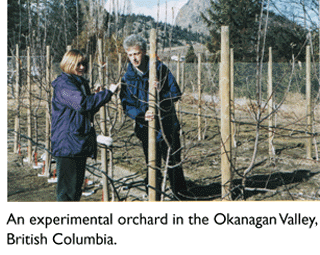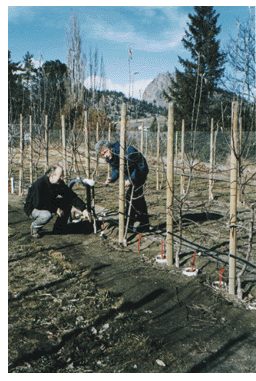 This page has been mothballed.
This page has been mothballed.
It is no longer being updated but we've left it here for reference.
Refining the Management of Fruit Orchards

- Collaborator
- Pacific Agri-Food Research Centre, Canada
- Macaulay Contact
Orchard management in British Columbia is utilising irrigation coupled with fertilisation, and the planting of a high density of trees growing on dwarf rootstocks (see photo). Such intensive systems offer the scope for developing more sustainable management protocols through determining the impacts of both fertilisation and irrigation on fruit crops. Using our knowledge of the processes of internal cycling of nitrogen in deciduous trees, through storage and remobilisation, we have collaborated with Agriculture and Agri-Food Canada to help refine apple orchard management procedures. In doing so we have been able to apply an understanding of tree physiology gained from experiments with sapling trees grown in controlled environments to 'scale up' to more mature trees growing in soil.
This collaboration is allowing us access to well maintained and instrumented experimental orchards, where we can apply isotope techniques with a precision usually only found in pot experiments.
 The timing
of fertiliser application on tree development and growth has been studied.
Because the majority of nitrogen used for tree growth each year can be
remobilised from storage, the requirements for fertiliser application have to
be considered in relation to tree development, and not just growth that year.
An adequate balance between fruit production and vegetative growth and a high
fruit quality is also necessary. Using novel 15N labelling techniques we have
shown that the growth of spur leaves and flowers in the spring relied almost
entirely on N remobilisation, whereas the shoot leaves which form the new
vegetative growth derived only half their nitrogen from remobilisation. This
finding explained why fertilisation of fruit trees often leads to yield
responses the following year, because spur leaves provide much of the carbon
used for fruit growth. The results also demonstrated that applying fertiliser
nitrogen to the trees during the first three weeks of their growth was wasteful
because the roots did not take any nitrogen up, despite there being a plentiful
supply.
The timing
of fertiliser application on tree development and growth has been studied.
Because the majority of nitrogen used for tree growth each year can be
remobilised from storage, the requirements for fertiliser application have to
be considered in relation to tree development, and not just growth that year.
An adequate balance between fruit production and vegetative growth and a high
fruit quality is also necessary. Using novel 15N labelling techniques we have
shown that the growth of spur leaves and flowers in the spring relied almost
entirely on N remobilisation, whereas the shoot leaves which form the new
vegetative growth derived only half their nitrogen from remobilisation. This
finding explained why fertilisation of fruit trees often leads to yield
responses the following year, because spur leaves provide much of the carbon
used for fruit growth. The results also demonstrated that applying fertiliser
nitrogen to the trees during the first three weeks of their growth was wasteful
because the roots did not take any nitrogen up, despite there being a plentiful
supply.
The potential for further manipulating fruit tree development and growth through the timing of N supply is being investigated. Orchard-scale experiments are investigating the impact of supplying nitrogen fertiliser during discrete, short pulses at key stages of the annual growth cycle of the trees. These treatments include supplying N during the period of fruit development in the spring and later on in the year after harvest to try and increase the amount of N allocated to storage for growth the following year. Interactions between fertilisation and irrigation are also being studied.
Future developments
Further developments are planned to examine the impact of tree nitrogen status on growth and development leading to fruit yield and quality. In particular, we aim to study the interactions between tree N status and storage capacity on the one hand, and the formation of both vegetative and flowering buds as a developing sink strength on the other.
Developing a conceptual model of these interactions will allow us to design further experiments to consider the timing of N applications in relation to both other management inputs (such as bud thinning) and the stage of tree development. The ultimate aim will be to enhance the sustainability of orchard management while also enchancing the quality of the fruit. Building on the collaboration will involve both linking the agronomic and molecular aspects of the research programme in Canada with our tree physiology studies at the Institute. In this way it is hoped to provide a route for technology transfer from our programme on tree ecophysiology to orchard managers, while continuing to allow us to 'scale up' our understanding of storage and remobilisation by working opportunistically on trees growing in intensively managed field experiments.

